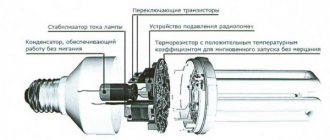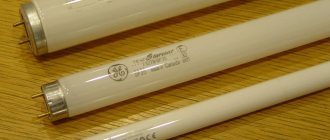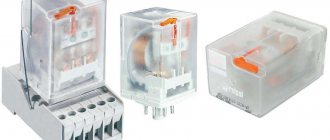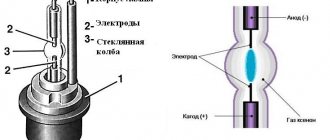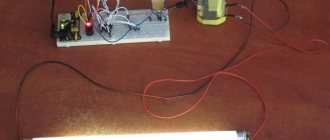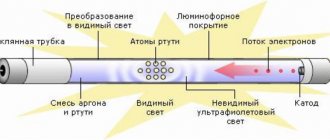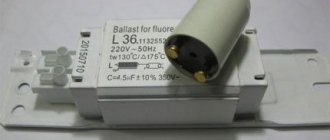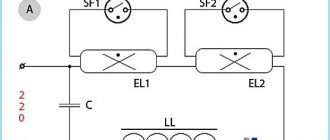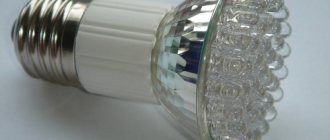A fluorescent lamp or fluorescent lamp (FL, LDS) is an inert gas in a glass bulb that emits visible light.
The principle of operation of the LDS is to saturate the gas with mercury and then pass a discharge through it, resulting in the formation of UV radiation, which is converted into visible light due to the phosphor layer contained in the inner surface of the bulb. This article will discuss LDS, their description and technical characteristics.
Application area
Fluorescent light sources are in great demand in public organizations: schools, hospitals, government agencies.
With further development, the lamps were equipped with electronic ballast, and it became possible to use them in common E14 and E27 standard sockets.
LL is more relevant to use in industrial premises to provide a larger lighting perimeter with minimal energy consumption. They are also used in lighting billboards and facades.
Luminescent devices combine the characteristic features of efficient and economical use of electricity. In everyday life, ceiling and table fluorescent lamps are used for plants, work surface lighting and living rooms.
Are there any errors in the calculations?
Since we have already made allowances for the features of each individual lamp, it is fair to clarify that there will be errors in the calculations. The most accurate indicators of the required illumination can be obtained using a special device - a lux meter.
But the tables we provide allow us to achieve a minimum level of error - it will definitely not affect either comfort or health. If it is not possible to use professional calculations, you can calculate everything yourself and choose the optimal solution.
Source: megawatt-lamp.ru
The relevance of the use of fluorescent lamps
LL has become widespread due to many advantages, namely:
- high luminous efficiency (10 W LDS provides illumination comparable to a 50 W incandescent light bulb);
- large range of shades of emitted light;
- complete diffusion of light.
The guaranteed service life of LDS is from 2 thousand hours versus 1 thousand hours for incandescent lamps.
Disadvantages of fluorescent devices:
- chemical hazard (LDS contains up to 1 g of mercury);
- uneven spectrum that is unpleasant to the human eye;
- gradual destruction of the phosphor layer, leading to a decrease in illumination;
- lamp flickering at twice the mains frequency;
- the presence of a mechanism that regulates the start;
- LL power does not provide a high coefficient.
Tips for choosing
When choosing fluorescent lighting sources, the following recommendations must be taken into account:
- The most profitable , from an economic point of view, are class A lighting fixtures, which have an efficiency ratio of 1:6 with incandescent lamps and are characterized by savings of up to 80% of electricity.
- To illuminate streets, bridges and other objects , it is possible to use 2-in-1 lamps that have 2 modes: normal operation and a mode with an energy consumption of less than 1 W, using sensors to switch to another mode under changing external conditions.
- the buyer needs to evaluate energy savings, power consumption and its service life.
- It is necessary to focus on the base of the lighting source and its dimensions and their compliance with the operating conditions of the buyer.
- When choosing a lamp, you need to pay attention to its color rendition and the temperature it reaches, since insufficient lighting in the room may result in a blue tint of the spectrum, which is unpleasant for family members.
- Do not buy lighting sources of this design for conditions with frequent switching on and off of the lighting device.
Work principles
During operation of the LL, an arc-shaped discharge burns between two electrodes located at its edges, which leads to the creation of UV glow inside a flask filled with a gas containing mercury vapor.
Human vision is immune to the UV range of luminescence, therefore the inner walls of the flask are treated with a phosphor composition that has the properties of absorbing ultraviolet radiation with its further conversion into a visible white glow. Calcium-zinc orthophosphates and halophosphates form the basis of the phosphor layer. Also, the phosphor can be saturated with other substances in order to obtain a certain shade of light. Thermionic emission of electrodes from the cathode creates support for the electric arc in the LDS. Further heating of the cathodes by passing current through them or by ion bombardment causes the device to start.
Parameters of standard types of light sources
Used for general lighting and have the following characteristics.
- Power: 18-58 W.
- Light flow:
- 1000-4000 lm (single-layer phosphor),
- 1300-5200 lm (three-layer phosphor),
- 1000-3600 lm (five-layer phosphor).
- Color rendering index:
- 50-76 (single-layer phosphor),
- 85 (three-layer phosphor),
- 93-98 (five-layer phosphor).
- Colorful temperature:
- 3000-7000 K (single-layer phosphor),
- 2700-7000 K (three-layer phosphor),
- 3000-5400 K (five-layer phosphor).
- Base: G13.
- Length: 590-1500 mm.
Specifications
The final operation of the LDS—the required lighting—depends on the technical characteristics.
Power
The light output, which affects the illumination area, depends on the LL power indicator. Lamps of various wattages are common in implementation.
Lamps 4–6 W
Suitable for small rooms. Great for agricultural areas, guardhouses or tents. These LDS are unpretentious in terms of electricity consumption, and thanks to transformer converters, these lamps are able to operate on 12 volts, which makes it possible to start the lamp by connecting it to a car battery in conditions of no power supply. Low-power fluorescent devices are also used to illuminate plants or aquariums.
18 W
The most common LL in terms of lamp power. They can be found everywhere: in a room, car garages, offices, pavilions.
36 W
They have also become widespread. They are used in the same rooms as LL 18 W, with the difference in increasing the lighting area.
58 W and 80 W
These high-power LDS are used only in large production workshops, storage facilities and hangars, in underground areas.
Sometimes LLs of such power can be found in open areas in conditions of high light scattering. Such LLs, unlike 18 W and 36 W lamps, are more energy-consuming and their use in everyday life or office lighting is unprofitable. They are also equipped with additional fluorescent lamps, which makes their use even more irrelevant as ceiling fluorescent lamps in small areas.
Colorful temperature
Another main parameter of LDS. The quality of lighting depends on the quality of light and color temperature. These parameters are displayed as a three-digit value on the device bulb.
Value 627
Complies with devices with 60% light quality and 2700K color temperature.
Value 727
Lamps with 70% light quality and similar color temperature.
Value 765
The color temperature is 6500 K, which is what all LDS have without exception. Color quality at 70%.
It is necessary to take into account that 2700 Kelvin is the color temperature of incandescent light bulbs, and a LL with the same color temperature will emit rays perceived by human vision that are yellow. Taking into account the human perception of the color of the glow, luminescent devices of different color temperatures are manufactured.
Many compact-shaped LLs (energy-saving light sources) emit yellow light. A color temperature of 6500 is common to all linear devices and corresponds to white light with a slight blue tint. Narrow-profile luminaires with a color temperature of 1300K are also manufactured, when turned on, a red tint is observed. In some cases, colored LDS are used to obtain a unique shade of glow.
Dimensions and efficiency
In order to obtain the maximum effect from an electric discharge, a certain temperature must be maintained in the internal space of the flask. In this case, the ultraviolet radiation of mercury vapor will be greatest. This parameter is directly related to the diameter of the flask. The fact is that the current density in all lamps should be approximately the same. This indicator is determined by dividing the current value by the cross-sectional area of the glass cylinder.
In this regard, lamps with bulbs of the same diameter, but with different wattages, are able to operate at the same rated current. There is a direct proportional relationship between the voltage drop and the length of the cylinder, which determines the energy efficiency class. That is, the longer the lamp, the higher its power, which is clearly reflected in the figure. With a diameter of T5 and 13 t, the length will be 52 cm, 21 watts - 85 cm, 28 watts - 115 cm. The diameter of T8 and a power of 15 watts correspond to a length of 44 cm.
Network connection
The simplest diagram for connecting fluorescent lamps is based on a starter, a choke (ballast) and a capacitor. The lamps themselves do not provide for their direct connection to an electrical circuit, since when turned off, fluorescent devices have high resistance, which can only be overcome by a high-voltage pulse.
It is also possible to connect two lamps in series, with 2 starters and one inductor, but it must be designed for the total power of the lamps. The diagram of a 2-lamp lamp is shown below. There is no capacitor in the diagram, but it can also be installed at the input of the lamp.
The schematic diagram of the lamp is sometimes applied to the starter housing.
The choke (ballast) is included in the electrical circuit as an additional resistance that protects against short circuits. The starter allows you to charge the inductor at moments of high lamp resistance and at the same time warm up the lamp coils.
It is impossible to start a fluorescent lamp without a throttle. The total energy consumption of all devices connected together with the fluorescent light source to the electrical circuit depends on how the connection diagram is arranged.
Electromagnetic choke (EMPRA)
A constant inductive reactance choke, connected only to a circuit with a LL of a certain power. When switched on, the resistance of the electronic ballast included in the circuit begins to play the role of limiting the current supply to the lamp.
The design of the electronic ballast is simple and cheap to produce, and accordingly, lamps with electromagnetic ballast are also cheaper. Despite its cheapness and simplicity, it has a number of disadvantages:
- startup duration up to 3 seconds (time depends on lamp wear);
- high power consumption by the throttle;
- a gradual increase in frequency in the throttle plates due to wear;
- flickering at twice the mains frequency (100 or 120 Hz) when turned on, which negatively affects vision;
- massiveness and dimensions of luminescent devices (in comparison with analogues of electronic ballasts);
- probable failure of the electrical circuit with the throttle mechanism at temperatures below zero Celsius;
- a short circuit leading to soldering of the inductor electrodes to the device, after which it cannot be removed.
The connection diagram for gas-discharge fluorescent lamps with electronic ballasts provides for the presence of a starter that regulates the ignition of the lamp. However, it additionally consumes electricity.
Electronic throttle
An electronic ballast (EPG) provides the lamps with high-frequency power 25–133 kHz. When the LDS with an electronic throttle is turned on, a person observes a bright flickering for a short time. Using an electronic ballast, two operating principles for turning on lamps are implemented.
Cold start
It starts the device immediately, but causes significant damage to the electrodes. Lamps with such starting options are designed for low frequency on/off during the day.
Hot start
Before turning on the lamp, the electrodes heat up for 1 second, then it works. There is also a thermal indicator that provides the device with protection against overheating.
LLs based on electronic ballasts are more economical, which is why they have gained significant popularity, which cannot be said about analogues of electronic ballasts.
Design features
What is this lighting device? Essentially, it is a glass tube sealed on both sides. Its inner surface is treated with a phosphor, air is pumped out of it and gas - argon - is added. Also, only one drop of mercury is added inside. It turns into vapor under the influence of temperature.
In order for the lamp to glow, it is necessary to apply an electric current inside its structure, which will raise the temperature. Therefore, electrodes are installed in the glass tube, which are tungsten wires twisted in the form of a spiral. Tungsten is coated with a special alloy of barium or strontium salt oxide. It is this layer that increases the service life of the electrodes. Here, two so-called hard electrodes are installed parallel to the spiral. They are nickel. Each such electrode is connected at one end to one of the ends of the spiral.
Causes of malfunction
LDS electrodes are represented by a tungsten spiral coated with active alkali metals that provide a charge. Over a period of operation, the active mass falls off from the electrodes and they become unusable.
At the moment the lamp is turned on (starting the discharge and subsequent heating of the electrodes), an additional load occurs on the active mass, which further destroys it. In areas with the greatest loss of active mass, less voltage is supplied, which leads to uneven output, and a person observes the flickering of the lamp during its operation. Also, shedding of the active mass leads to complete malfunction of the lamp, and a dark tint appears at the ends of the tube.
It follows that the service life of the LL also depends on the quality of the active mass and the frequency of switching on the lamp. But even with these limitations, the service life of the LDS is at least much longer (2000 starts versus 1000 for conventional incandescent light bulbs).
Launch equipment
Modern industry today produces two main types of fluorescent lamps:
- in addition to which it is necessary to purchase a starter;
- with the possibility of inclusion in a circuit with ballast, without starting equipment;
- universal.
The first type of equipment is marked as Phs, the second - RS, the third - US. Sometimes the letters characterizing the method of starting the lamp may not be in the code. This means that the starter for this equipment is a mandatory element.
Types of execution
Luminescent devices are divided into two types according to the design of the bulb.
Linear lamps
These LLs are represented by low pressure mercury lamps. Most of the light from these lamps is emitted by phosphor. Luminescent devices mounted on the ceiling are the main representative of linear luminaires. The fluorescent ceiling lamp has received huge demand all over the world in premises for various purposes.
Among linear lamps in Russia, LDS with a T8 round tube (D=26 mm) and a G13 base are common. The power of these lamps is related to the size of the tube - standard 18 W LDS have a tube length of 600 mm, and 36 W lamps are already twice as long, 1200 mm. There are also lamps of other powers, but they are less widespread or have a narrow range of applications.
It is worth noting that in the Soviet period, LDS with a T12 flask, the diameter of which was 38 mm, were most widely used. These lamps were more energy-consuming - 20 W short and 38 W long versus 18 W and 36 W, respectively. There were also lamps with a T10 tube (32 mm), but they were not in widespread demand compared to T12.
In Western countries, in recent years, lamps with the latest generation T5 tube with a diameter of 16 mm have become predominant. They are quite thin and have received more extensive use in the interior.
If we touch on technological progress, then just recently Chinese developers created a device with a T4 flask (12.5 mm). This is only a new product that has not yet received widespread use, and it is too early to talk about the prospects of such tubular lamps. LDS with an even smaller tube diameter have not yet been made in practice.
A double-ended straight lamp is a glass tube with glass legs welded at the ends into which electrodes are mounted. The hermetically sealed tube contains argon or neon enriched with mercury, which turns into a gaseous state when the lamp is turned on. The sockets at the ends of the tube are equipped with contacts for connecting the lamp to the circuit.
Linear LDS consume only 15% of the consumption of an incandescent lamp, providing similar illumination. These lamps are often found in production, offices, and transport.
Compact lamps
They are fluorescent lamps with a curved tube.
Compact lamps can have a free (any) bulb shape and are common for private use. Compact fluorescent devices also include so-called energy-saving lamps.
Also common are compact lamps chambered for E14, E27, and E40 standards, which are used in lamps.
What can be the power
This parameter is indicated in the marking by the letter W and the numbers following it. Knowing the power of a fluorescent lamp, you can determine how large a room it can illuminate. For example, this indicator can be coded as 11 W, 15 W, 20 W.
With regard to power, the designations in the marking of fluorescent lamps correspond to certain codes of the same equipment with an incandescent filament. These ratios are indicated in special tables. The data presented in them can greatly facilitate the buyer’s choice. For example, the designation 11 W will correspond to an incandescent lamp power of 55 W, 15 W - 75 W, 20 W - 100 W.
Application options
Currently, luminescent devices are widely used both in lighting industrial facilities and in organizing the interior of a room. Lamps with fluorescent and white light lamps are used for many purposes:
- Low pressure fluorescent lamps LB 40, designed to illuminate the entire area of a closed room.
- Fluorescent lamp for aquariums and indoor plants, providing local lighting.
- Phytolamps (floral lamps) are fluorescent lamps for flowers and plants.
- A table and wall fluorescent lamp that provides soft lighting for a cozy atmosphere when reading or relaxing.
Classification
There are several criteria for classifying such electrical products. They can:
- emit daylight or white light;
- have different widths of the transverse tube (as it increases, the power of the lamp increases, on which the possible area of the illuminated room depends);
- have several contacts;
- produced with or without a starter (in the second case, the model is more economical);
- work from a network of different voltages;
- differ in shape (arc, spherical or spiral).
Marking
The labeling is designed so that the consumer can easily select the required LL when purchasing. The most common designations are:
- LB (white light);
- LD (daylight);
- LCB (cold white light);
- LTB (warm white light);
- LE (natural light);
- LHE (cold natural light).
The visible hue is directly dependent on color temperature. The color temperature of LDS is 6400–6500K, which corresponds to the approximate color of white light.
In addition to the type of lamp, the necessary technical characteristics of the lamp are also indicated: voltage, shape, dimensions, and so on. The marking is applied to the glass flask or LDS body.
Without exception, all LDS contain gases saturated with mercury vapor. In accidents where the lamp breaks, mercury vapor enters the air.
In the future, mercury may end up in the human body and cause harm to health. Therefore, you should handle fluorescent lamps with care.
Voltage
Most fluorescent lamps produced by modern industry are designed for use in a standard household electrical network. That is, most often such equipment operates at a voltage of 220 V.
However, fluorescent lamps of 127 and 75 V are also available for sale today. The first type of such equipment, designed for reduced voltage, is used in the subway. 75 V lamps are usually installed in electric trains.
The markings indicate the voltage required for such equipment directly. That is, exactly 220 V, 127 V or 75 V.
Where can I buy
You can purchase LED lamps as quickly as possible at your nearest specialized store. The optimal option, in terms of price-quality ratio, remains purchasing from the AliExpress online store. Mandatory long waits for parcels from China are a thing of the past, because now many goods are in intermediate warehouses in destination countries: for example, when ordering, you can select the “Delivery from the Russian Federation” option:
| Goodland E27 LED lamp 220V | 2 pcs/lot LED lamp E14/E27, from 3 to 20 W | LED corn lamp for refrigerator, 2 pcs/lot, 3 W, E14 |
| Bluetooth LED Bulb, E27, E14, GU10, RGB | LED night light Plutus-Quinn | 10 pieces. LED lamp E14/E27 |
Here is an example of calculations
Let's say you have a children's room measuring 10 square meters and three meters high. In this case, we take the norm for children’s rooms - 200 lm/m2 and the coefficient for ceilings from 2.7 to 3 meters - 1.2.
We multiply these indicators: 10m2 x 200 lm/m2 x 1.2 = 2400 lm.
It turns out that for this nursery you need a luminous flux of 2400 lm. Based on this indicator, you can select the number and type of lamps by referring to our first table. This is a very convenient formula because it allows you to quickly and easily obtain indicators for each room.
Price for one
Table - Cost of the most popular models of lighting devices
| Marking | Manufacturer | price, rub. |
| LPO 2x18 | Xenon | 303 |
| LPO 2x18 | Beloretsk | 336 |
| LPO 2x18 | Verona | 570 |
| LPO 2x36 | Xenon | 603 |
| LPO 2x36 | Beloretsk | 248 |
| LPO 2x36 | Verona | 684 |
| LPO 4x18 | Xenon | 750 |
| LPO 4x18 | Beloretsk | 580 |
| LPO 4x18 | Verona | 706 |
You can choose the most reasonable price by comparing the prices and characteristics of different manufacturers.
